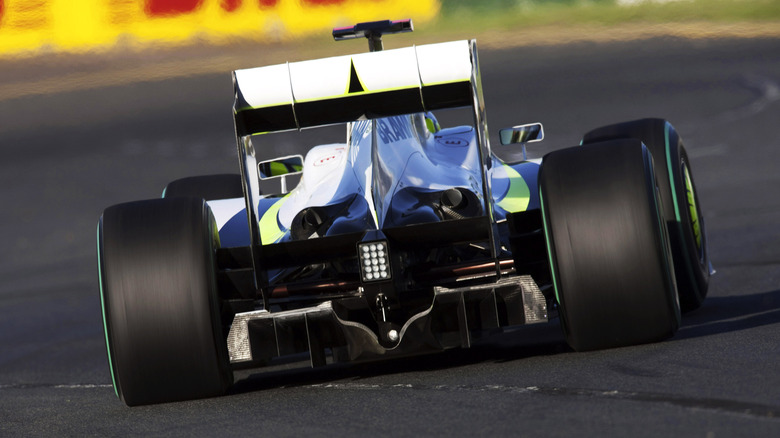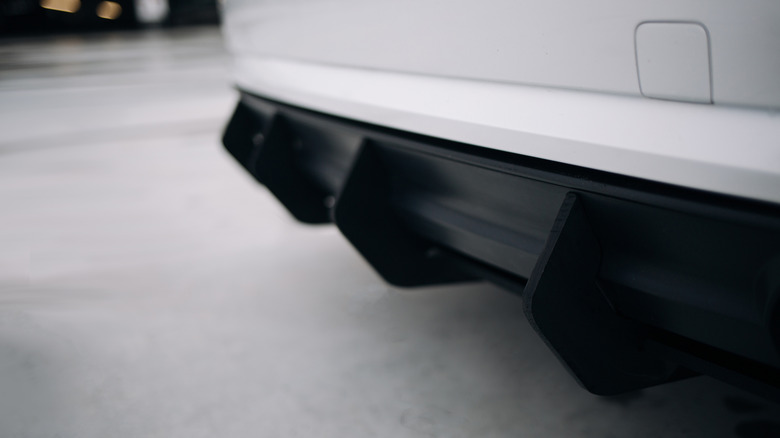What Is A Rear Diffuser For In A Car?
Aerodynamics plays an important role in a vehicle's handling, especially when a vehicle is at speed. The faster a car goes, the more air interacts with elements like the bodywork, front and rear wings, and undertray to generate downforce. Much like how aircraft produce lift to push them up, cars use aerodynamics to press them down, increasing grip at the cost of additional drag. This is what allows Formula One cars to pull upwards of five-plus G's in a turn, pushing the boundaries of what a human can sustain over the course of a race.
While it's fairly intuitive to understand the general how rear spoilers affect downforce, it's somewhat harder to grasp what occurs underneath the car. As a car moves, air passes over and under the body, generating various areas of low and high pressure that affect the car in different ways. A rear diffuser acts as the final physical object on the car that directly manipulates the airflow passing under it.
Diffusers create a low-pressure area behind the car, which accelerates the air passing through and lowers its density. This sucks the car to the ground like a vacuum, producing downforce and improving stability and fuel efficiency. Let's dive into the physics of how exactly these devices work and what their benefits are in different applications.
The physics of underbody airflow and diffusers
The key factor to a diffuser's function relies on the manipulation of air pressure. Air passing under the car is subjected to a phenomenon called the Venturi effect. In short, this happens when forcing air through a space tighter than its starting point, causing the air to speed up. It's like lanes on a highway: if it moves drops from three lanes to two, cars would have to travel faster on those two lanes to maintain the same throughput as a three-lane highway. This bottleneck is why air travels faster under a car, creating a region of low pressure.
The rear diffuser comes into play as the air exits the back of the car, transitioning from fast-moving low-pressure to ambient pressures. A diffuser acts directly on this point when the air is at its lowest pressure and moving fastest, smoothing out the airflow during this critical period. This enhances a car's ground effect, or the air pressure sucking a car to the ground.
Numerous factors determine the shape of diffusers, such as a vehicle's ride height and the height differential between the front and rear (or rake). In addition, many diffusers feature vertical slats, called strakes, which act as guides for airflow. Lastly, a car's exhaust gases impact a diffuser's shape; exhaust contains fast-moving, hot air, which can be exploited to alter the air density behind the car. Of course, that's not the only way motorsports utilizes exhaust to generate downforce; for example, the 10,000-plus-hp engines in Top Fuel dragsters are so powerful that the exhaust pipes create downforce that pushes them into the ground.
The benefits of diffusers
A diffuser's effect is most apparent in high-speed applications. There, it effectively creates an expansion chamber for air that doesn't generate large amounts of drag like a wing. This means that a properly-shaped and angled diffuser can redirect airflow without the top speed penalty associated with high-downforce wing setups. Vehicles without diffusers have a low-pressure air pocket that forms behind them as they push through the air, creating turbulence and drag. Because a diffuser expands the air moving under the car and redirects it upward, that air will flow into this pocket and minimize its size, thus reducing drag.
Because diffusers rely on expanding air and redirecting airflow, the angle plays a significant role in their effectiveness. If a diffuser is too shallow, it won't expand the air properly. Conversely, a diffuser that's too steep forces the airflow to separate, subsequently increasing drag.
Despite typically being associated with motorsports and cars with extreme aerodynamics, diffusers actually benefit everyday vehicles as well, though not as drastically. On regular cars, these devices still perform the same job, reducing drag and improving stability at higher speeds for greater fuel efficiency and higher grip levels. Much like their racing counterparts, these effects only apply to properly-shaped diffusers and generally improve the lower a car is to the ground, providing the highest benefits on low-slung sports cars, luxury sedans, and large commercial vehicles looking to maximize efficiency by decreasing that air pocket left in their wake. Many cars today feature diffusers, including the reasonably affordable Toyota GR Supra 3.0 we reviewed in 2024.


